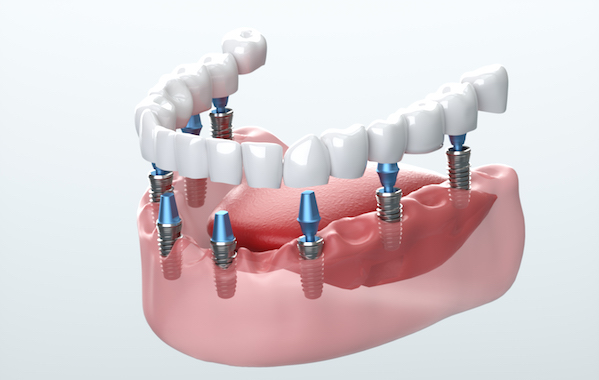The Best Guide To Dental Sense
The Best Guide To Dental Sense
Blog Article
The Best Strategy To Use For Dental Sense
Table of ContentsGetting My Dental Sense To WorkFascination About Dental SenseDental Sense Things To Know Before You Get ThisThe Only Guide to Dental Sense
are medical devices operatively implanted right into the jaw to recover a person's capability to chew or their look. They give support for man-made (phony) teeth, such as crowns, bridges, or dentures. When a tooth is shed as a result of injury or disease, a person can experience difficulties such as fast bone loss, faulty speech, or changes to eating patterns that result in pain.Oral dental implant systems contain an oral implant body and dental implant abutment and might also include an abutment addiction screw. Root canal procedure. The oral implant body is operatively put in the jawbone instead of the tooth's root. The dental implant joint is typically affixed to the dental implant body by the joint addiction screw and expands through periodontals right into the mouth to support the attached man-made teeth
(https://www.slideshare.net/matthewmusic33101)Framework of The Dental Implant System choosing dental implants, talk with your dental service provider concerning the prospective benefits and dangers, and whether you are a candidate for the treatment. Things to consider: Your overall wellness is a vital factor in establishing whether you are a good candidate for oral implants, just how long it will take to recover, and how much time the implant may remain in location.
Smoking may influence the recovery procedure and decrease the lasting success of the implant. The recovery procedure for the implant body may take numerous months or longer, throughout which time you commonly have a short-lived joint instead of the tooth. the oral implant procedure: Thoroughly adhere to the oral hygiene guidelines offered to you by your oral provider.
The Greatest Guide To Dental Sense
Implant failing can result in the demand for another operation to take care of or change the dental implant system. Recovers the capability to chew Restores cosmetic look Helps keep the jawbone from reducing because of bone loss Preserves the health and wellness of the surrounding bone and periodontals Assists maintain adjacent (nearby) teeth steady Enhances lifestyle Damage to surrounding all-natural teeth during dental implant placement Injury to the surrounding tissues during surgical procedure, such as sinus opening Injury during surgical treatment (for instance, fracture of bordering jawbone) Insufficient function, such as really feeling like the teeth do not bite with each other typically A feeling that the tooth is loose or turning in place arising from a joint screw loosening up Implant body failure (looseness of the implant body) as a result of systemic infection, which may be more probable in clients with uncontrolled diabetes mellitus because of regional infection in bone and gum tissues supporting the implant body because of postponed healing, which may be most likely in patients who smoke Problem cleaning the periodontals around the implant, resulting in poor oral hygiene Untreated gum condition Post-surgical numbness because of nerve impingement or damage Always alert health and wellness care suppliers and imaging technicians that you have dental implants before any type of magnetic vibration imaging (MRI) or x-ray procedures.
FDA is not conscious of any kind of damaging events reported for MRI or x-ray treatments with oral implants. this content Dental implants systems are usually made from products that follow worldwide agreement requirements of the International Company for Standardization (ISO) or ASTM International. These criteria have information of what makes a risk-free product.

A dental implant is a framework that replaces a missing out on tooth. With screw-like devices, the surgeon inserts a dental implant right into the jawbone, and it acts as a support for a fabricated tooth, called a crown.
The smart Trick of Dental Sense That Nobody is Discussing
Some people are not qualified for dental implant surgical procedure. It is for oral surgeons to operate on people with: severe illnessuncontrollable metabolic diseasebone or soft cells disease or infectionIf these concerns are settled, a person can have the surgical treatment. In, dental cosmetic surgeons avoid running on individuals with: If individuals with any one of the above go through oral implant surgery, there is a greater threat of the dental implant falling short.

Oral implant surgical treatment is a personalized process. It's not the exact same for every person. But the adhering to gives a basic review of what you can anticipate your dental expert, dental specialist, periodontist or prosthodontist to do: Put the dental implant surgically. Give you time to heal. Connect the message and final crown, bridge or denture.
Next off, your doctor will very carefully position the oral implant into your jaw. Lastly, your specialist will certainly rearrange your gums and shut the cut with stitches. If your implant is near the front of your mouth, your dental professional will certainly make a short-term tooth for you to put on up until you heal. This way, you won't have a space in your smile while you recuperate.
The Basic Principles Of Dental Sense
Your provider can tell you what to anticipate in your scenario. Throughout the recovery stage, your jawbone should fuse to the dental implant. This process, called osseointegration, is important for stability and long-lasting success. This process can take anywhere from three to nine months. In many cases, it may take longer.
Once your implant heals, your dental expert can attach the joint (little connector article) and your final reconstruction (crown, bridge or denture). This normally takes concerning one hour to finish and might call for a 2nd small surgical procedure. You should not really feel any kind of discomfort during your dental implant procedure because your provider will make use of drug to numb your gums.
Report this page